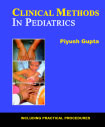|
|
|
Indian Pediatr 2010;47: 1 83-184 |
 |
Book Reviews |
|
 |
Clinical Methods in Pediatrics
Piyush Gupta
New Delhi:
CBS Publisher and Distributors;
Pages 520, Price Rs. 595.00 |
Though it has been over 12 years now that Pediatrics
became an independent subject for undergraduate students, the paucity of
good books for them can still be felt. It is at this juncture that the
book seems to fill a void. The book helps the student both UG as well as
PG in the art and science of clinical practice related to Pediatrics. The
best thing about the book is its style pf presentation and a very careful
effort has been made to present the material in a reader friendly way. A
number of tables, boxes and judicious use of color to highlight the
important points should make it very easy for the students to organize the
information in their memory. Although primarily a book on clinical
methods, it provides ample theoretical inputs to make the presentation
understandable. Diagrams and pictures are of a good quality. The chapters
on procedures should be useful for all levels of students. This book can
be recommended as a standard reading for undergraduate students right from
the beginning of their clinical postings. Postgraduates will find it
equally appealing. I have no hesitation in strongly recommending this book
to anyone concerned with care of normal and sick children.
Tejinder Singh,
Program Director,
CMCL-FAIMER Regional Institute,
Convenor, MCI Nodal Center for Faculty Development, Professor and Head of
Pediatrics,
Vice Principal,
Program in charge, PGDMCH (IGNOU)
Christian Medical College,
Ludhiana 141008
Email: [email protected]
|
|
 |
Clinical Evaluation of Newborns, Infants
and Children
S Sushma Bai
New Delhi: JP Brothers Medical Publishers 2009;
Pages 211, Price. Rs. 495.00 |
The strength of the book is that it asks its readers to
acquire the communication skills. Elicitation of the history, which is the
most important part of the patient work up, had been dealt in good
measures. It would have completed the description if prior treatment
history had also been included. Dietary history lacks importance of
breastfeeding and nutritive value of breast milk has not been highlighted
in the description of complementary feeding.
The description of the general physical examination and
growth and development of the child have been written with a good blend of
years of experience and simple illustrative approach. The limitation is
that only CDC-2000 growth tables and charts have been used. It would have
been better to include WHO growth charts as well.
The examination of the newborn baby seems sufficient
for an undergraduate medical and nursing student to differentiate a sick
neonate. The systemic examination part is adequately written and students
will find it easy to elicit many signs and to describe abnormalities.
Author has worked hard to reproduce better quality clinical photographs
liberally to help student learn the clinical situation which they may not
have a chance to see as a clinical case during ward posting. Pedigree
charting, reading of ECG and skiagrams of chest are good additions.
Overall the book gives a pleasant reading and can be recommended to the
undergraduate students.
MMA Faridi,
Professor and Head, Department of Pediatrics
University College of Medical Sciences
Delhi-110095
|
 |
Pediatric Gastroenterology, Hepatology and
Nutrition
Suraj Gupta and Karoly Horvath
Delhi: Peepee Publishers and Distributors (P) Ltd;
Pages 764, Price: Rs. 795.00 |
This is a comprehensive, very well written and edited
piece of work. The preface has stressed the important fact that Pediatric
Gastroenterology and Hepatology are important subspecialities of
Pediatrics and the approach to disorders involving the gastrointestinal
tract and liver in children requires to be suitably modified as compared
to adults. The practical application of clinical nutrition in medical and
surgical disorders has not received appropriate attention in India. The
fact that the importance of nutritional support in the management of
gastrointestinal and liver disorders in children needs to be underscored
has received appropriate mention.
The textbook is conveniently divided into four sections
- Gastroenterology, Hepatology, Nutrition, and Investigations. The book is
reader-friendly and useful to practicing pediatricians, in addition to
medical graduates who are interested in specializing in these subjects.
Sarath Gopalan,
Executive Director,
Centre For Research on Nutrition Support Systems (CRNSS),
C-13, Qutab Institutional Area,
New Delhi-110016, India.
Email:
[email protected]
|
|
 |
Essential Pediatrics, Seventh Edition.
OP Ghai, VK Paul and A Bagga
New Delhi: CBS Publishers;
Pages 768, Price: Rs. 695.00 |
Ever since inception, this book has firmly established
itself as a standard text for undergraduates. The silver jubilee edition
(seventh edition) bears ample testimony for this statement. Over these 25
years of existence, some editors have changed and now even the creator of
the book has left for his heavenly abode. However, the quality and
popularity of the book has been improving steadily.
This edition highlights extensive revision in most
chapters to effectively meet the current and updated needs of the target
audience. While ample justice has been done to the existing priorities
like nutrition and infectious diseases, emerging areas such as genetics,
adolescence, intensive care and care of children with chronic systemic
diseases have also received due attention. The current public health
perspectives in relation to child health have not been ignored. The
quality of production has also substantially improved. The book is
recommended for undergraduates. practicing pediatricians, and for
postgraduates, particularly DCH students.
HPS Sachdev,
Senior Consultant Pediatrics and
Clinical Epidemiology,
Sitaram Bhartia Institute of Science and Research,
B-16 Qutab Institutional Area,
New Delhi 110016.
Email: [email protected]
|
|
|
 |
|

